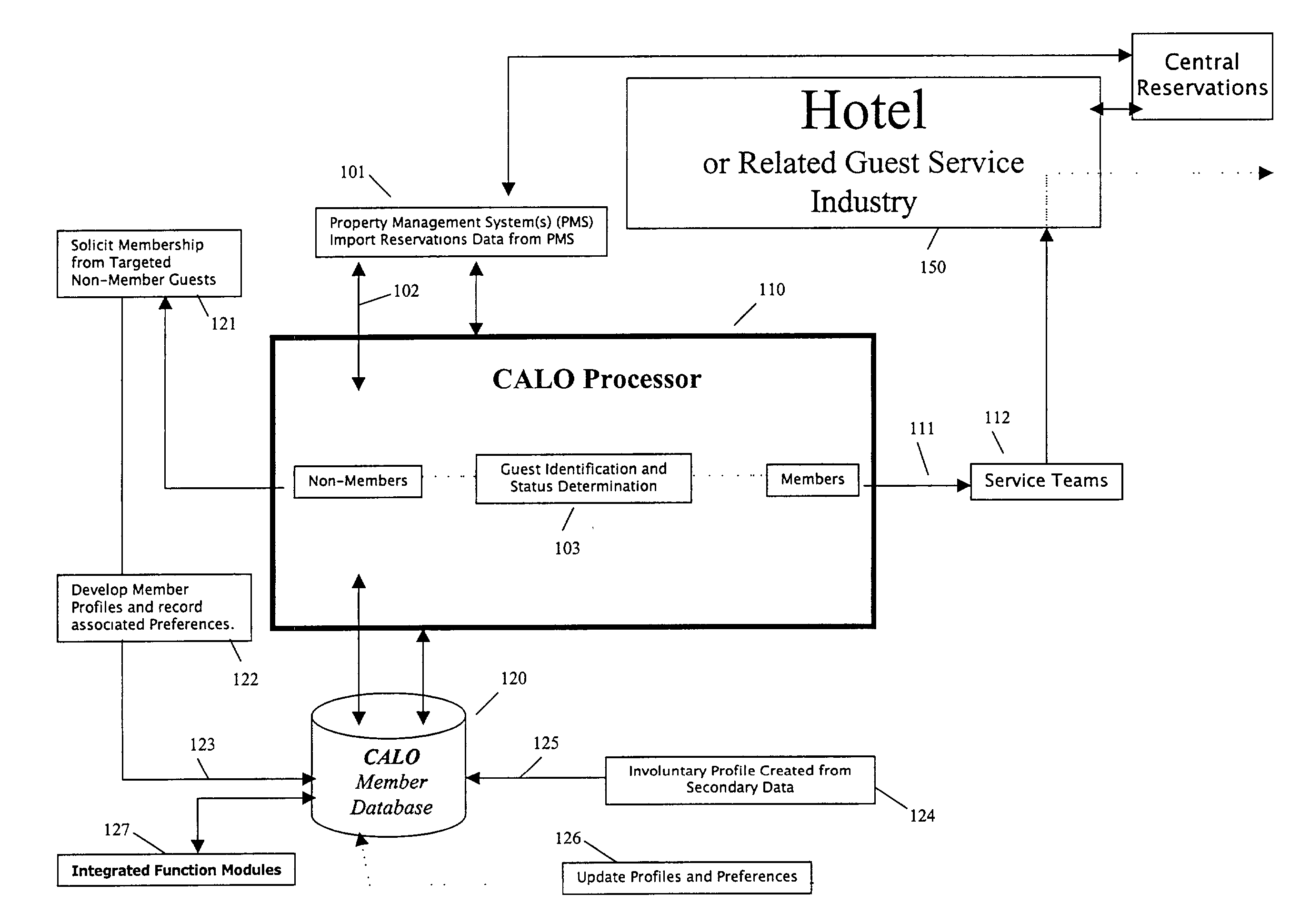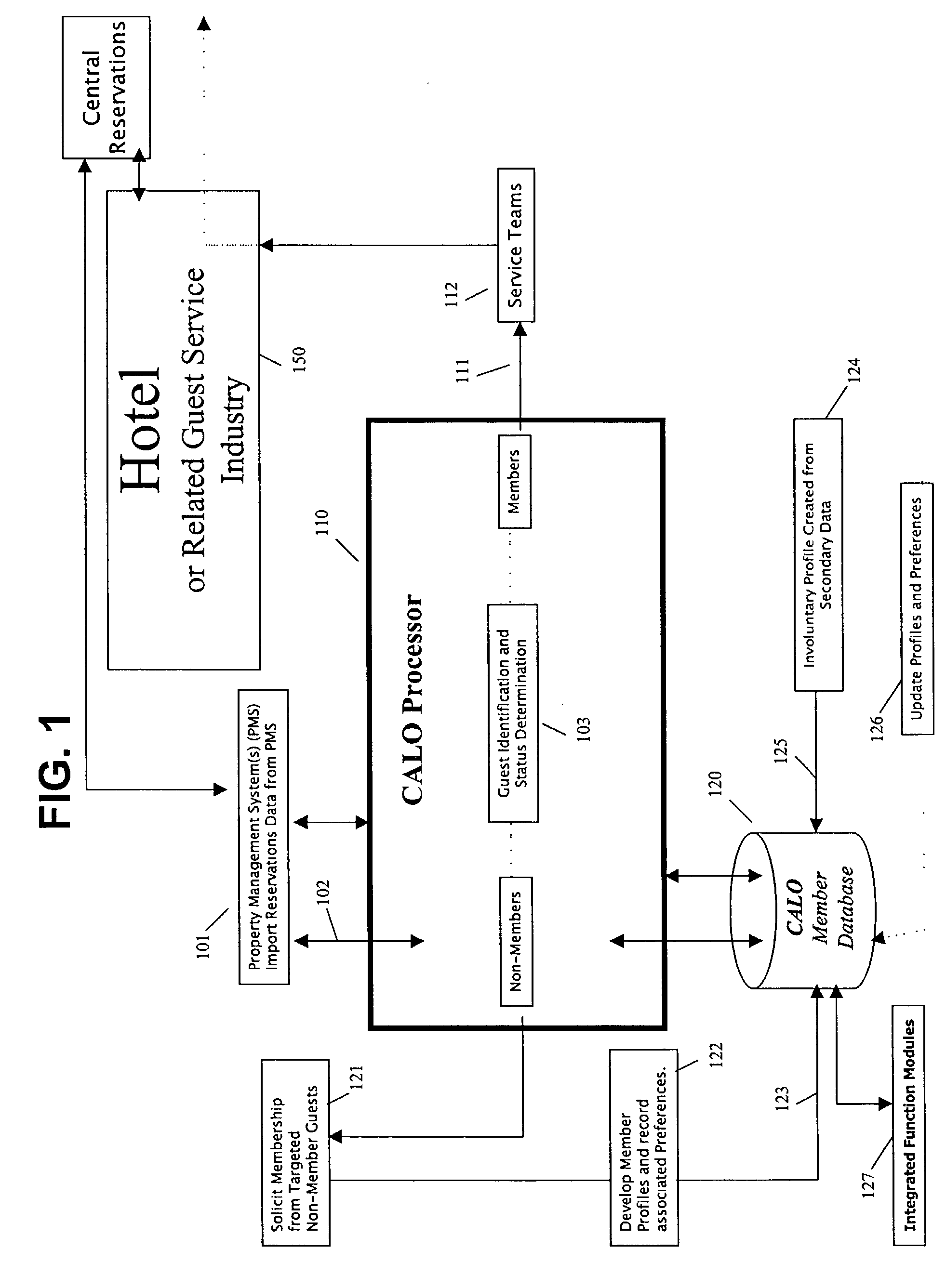Industry consolidation, growth and various ownership and management structures have created challenges in the way in which frequent guest programs have been implemented.
And few attempts, if any, have been made to coordinate
customer information across affiliated hotel properties.
Individual hotels face both operational and technical barriers to coordinating customer profile data for use within each specific hotel as well as across affiliated properties.
Guest data accumulated by different systems even within the same hotel are very often in different and incompatible formats.
There is no ready means to consolidate this data or make it easily available for use at other hotels.
However, there are no systems that are capable of performing these functions.
However, there are problems and disadvantages with such systems.
For example, one problem is that the current approach and technology employed by hotel companies fails to create a capability for consistent and extended guest recognition.
This approach limits the target audience for guest recognition to program participants who have successfully provided an accurate identification number at the time of reservation.
More important, since hotel companies access guest reservations at the CRS instead of from the individual property management systems (PMS) at each hotel, there is no capability to identify the status of any given reservation (cancelled, no-show, in-house, checked-out) at any point throughout the guest's planned stay other than a scheduled arrival on or before the day of arrival.
This approach limits the ability to recognize and service a targeted guest throughout the course of a multi-day stay.
A second problem with current systems is their inability to allow a multiplicity of hotels in geographically dispersed locations to share guest information.
One hotel within a chain may have recorded details of a guest's preferences, interests and history but, with the current systems, neither the central reservations
system nor any other affiliated hotel's property
management system can access this guest data.
A third problem with existing systems is an inability of hotel properties or hotel groups to consolidate guest data to provide a complete view of the guest and to allow guest information to be easily accessed, manipulated and modified.
The inability to consolidate guest data and the lack of local access to guest data prevents hotels and hotel companies from serving specific guests with a current awareness of the guest's stay history, spending, interests, complaints and other
relevant information.
A fourth problem with the existing systems is that the amount and type of information that may be transferred between systems is limited.
Because one chain of hotels may support a variety of different property management systems, each with limitations on available fields in which to
record guest data, the transfer of information between the CRS and the PMSs is limited to the basic reservation data, such as the guest's name, arrival and departure dates, and a limited set of two-letter guest preference codes such as "NS" to denote a request for a non-smoking room.
A fifth problem with the existing hotel systems is the absence of a programmable fulfillment
system capable of automated on-
property distribution of guest information.
There is no capability within either a hotel's property
management system or a
system working in conjunction with the PMS to program events to systematically support various guest preference fulfillment scenarios.
It is not currently possible to program the PMS to identify the next arrival or a specific arrival of a specific guest and, following the identification of a targeted guest, produce and distribute output for various hotel operations teams depending on the attributes defined in the guest's reservation and the corresponding guest's profile and also depending on the service standards defined by each individual hotel.
Additionally, there exists no capability within the current systems to produce and distribute such output throughout the entire lifecycle of a guest's hotel experience including pre-arrival, at check-in, while the guest is in the hotel, at check-out and post check-out.
A sixth problem with the existing hotel systems and methodologies is the limited scope of guest profiles and profiling activity.
The current definition of a guest profile limits the opportunity to develop an in depth understanding of the guests, their activity, interests and value as it has a limited scope and fails to integrate with other systems which
record guest information.
Also, since profiles are only created for guests who voluntarily join the hotel's frequent guest program, hotels and hotel companies fail to address the majority of their guests, many of whom may be significant contributors to an individual hotel and to the chain.
A seventh problem with the current systems is the inability of hotels to maintain and manage a dialogue with guests throughout the lifecycle of a guest's hotel experience, from the reservation to after the guest has checked out.
There are no systems in place to manage the
information exchange between the hotel and the guest to enhance the guest experience, reduce the likelihood of service errors and capitalize on marketing opportunities.
There are no systems designed to systematically communicate with the guest utilizing individualized guest information from the guest's profile at each stage of the guest's stay experience; before arrival, at check-in, while in the hotel, at check-out and after check-out.
An eighth problem with the current systems is that there exists no capability for individual hotels to initiate and manage marketing campaigns utilizing guest profile data from guests who have visited their individual hotels.
An additional problem with the current systems is that guests have limited, if any, access to review or modify their own personal profile information or to exchange data with the hotel or the hotel company.
There exists no capability to submit non-standard preferences or to customize the delivery requirements to meet specific guest-defined rules.
Additionally, there is no capability to interface with the hotel or hotel company to exchange information such as downloading folios, submitting on-line guest comment cards or requesting to be notified for specific offers or events consistent with defined guest profile attributes.
Yet another problem is the limitations imposed by the architecture of the existing systems.
Hotel chains face limitations because their hotels do not utilize one single standard PMS.
 Login to View More
Login to View More  Login to View More
Login to View More 


